Designing and laying out lighting for a cricket field can be challenging, especially for older sports facilities that may need updates or for new stadiums being built from scratch. The process often involves numerous adjustments and considerations, making a comprehensive guide essential for either starting a new project or staying current with the latest advancements.
In this detailed guide, you’ll find a wealth of explanations and examples. Cricket is a widely followed sport in countries such as India, South Africa, New Zealand, Pakistan, Bangladesh, Australia, and the UK. The guide will cover general lighting standards for cricket, as well as specific requirements for different levels of competition. This approach will help you better understand and apply the information in line with your local cricket association’s guidelines.
We will begin by exploring the fundamental components of cricket field lighting. Once you are familiar with the latest LED lights available, we will delve into additional topics related to cricket ground lighting.
Table of Contents
ToggleWhat is a Cricket Stadium Lighting System?
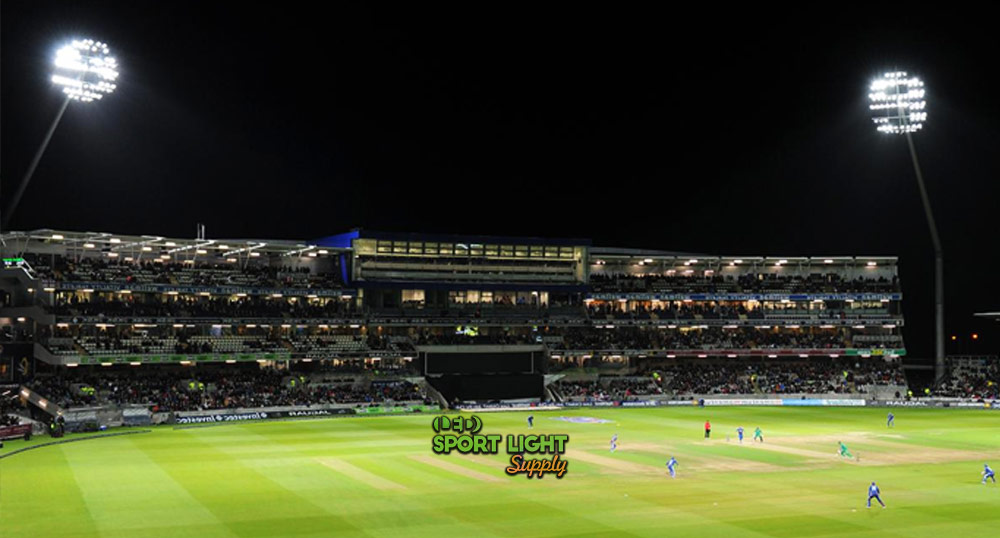
A cricket stadium lighting system encompasses the entire lighting setup designed to ensure optimal performance, safety, and efficiency. This system includes all necessary components such as fittings, sockets, frames, light poles, walls, cables, and electricity.
One of the primary objectives of the lighting system is to comply with the cricket association’s lighting standards. These standards outline specific requirements for each aspect of lighting to ensure it meets the necessary criteria for cricket games. A typical cricket stadium lighting assembly consists of several critical components.
High Power Lighting Fixtures
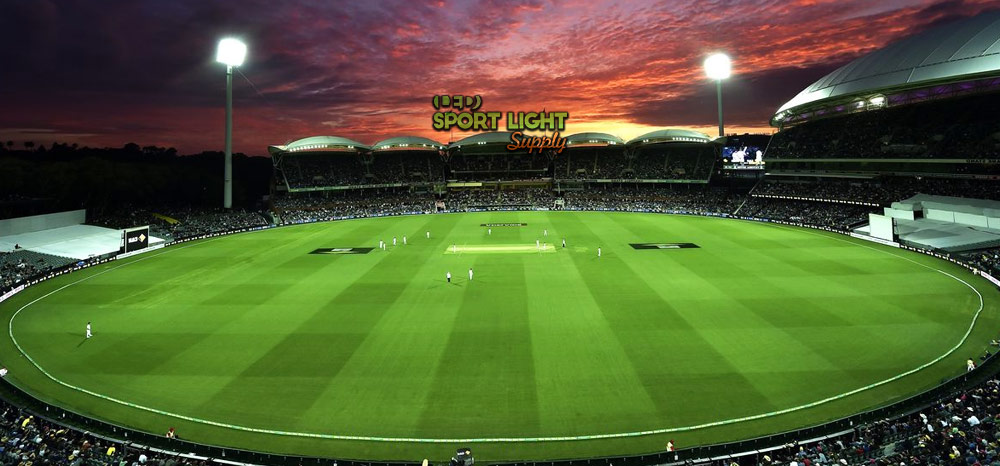
To illuminate a cricket ground, which can extend up to 150 meters, high power lighting fixtures are essential. These fixtures provide the necessary brightness for players and umpires on the field. Common wattage outputs for LED cricket stadium lights are 400W, 1000W, and 2000W. LEDs, or Light Emitting Diodes, are highly efficient optoelectronic devices that convert electrical energy into visible light with minimal heat dispersion and no ultraviolet or infrared radiation.
High Mast Light Poles
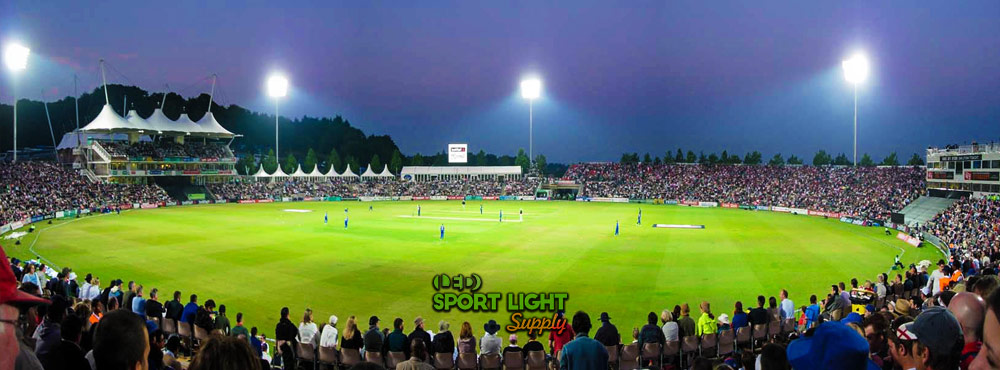
Light poles are crucial for any outdoor stadium, and high masts are typically between 14 and 40 meters tall. These poles are strategically placed around the cricket ground based on a lighting layout designed by a lighting designer. The height and placement of each pole depend on factors such as the dimensions of the field and the level of competition, particularly for international and first-class events where optimal lighting conditions are required.
Lighting Control System
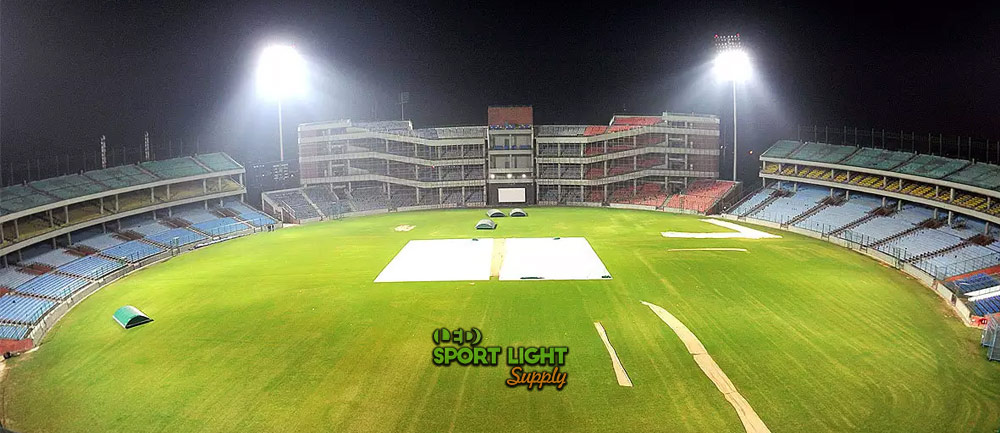
Modern lighting control systems allow for remote management of stadium lights via apps or Bluetooth connections. Systems often use DMX or DALI controllers. DMX operates through a 3-pin cable to send numerical values to 512 channels, while DALI interfaces with up to 64 channels. Advanced systems may use a control module to manage both DALI and DMX lights simultaneously.
User Interface
The user interface for controlling cricket stadium lights can include physical panels, computers, or smartphones. Specialized software typically allows for adjustments in brightness, color, and special effects, although universal software options are also available. Some systems connect directly to WiFi, allowing users to control individual fixtures with password protection to prevent unauthorized access. User interfaces often feature scheduling capabilities for creating custom lighting programs.
Pole and Underground Cabling
Ensuring the security of light poles and cabling is essential for both safety and functionality. Electrical wiring is routed through the high masts and exits underground to connect with the grid and controller. The lighting layout must account for access areas and maintenance needs. If the existing cabling system is outdated, temporary lighting solutions may be used while awaiting upgrades.
Lightning Protection System
Outdoor cricket stadiums are vulnerable to lightning strikes, making a lightning protection system crucial. This typically involves installing a lightning rod or conductor on top of light poles. Different countries have specific standards for lightning protection, such as AS/NZS 1768:2007 in Australia and New Zealand, BS EN 62305-3:2011 in Europe, and IS 2309 (1989) in India. A reliable lightning protection system ensures the safety of players, umpires, spectators, and the lighting equipment.
Power Supply
The power supply for a cricket stadium is typically sourced from electricity generated at power plants. However, transportation and distribution can be complex, particularly in remote areas. This is why many stadiums are located in urban areas where power supply issues are less common. Reinforced insulation protects against electric shocks, and the power supply must be adequate to support the LED luminaires. Alternative power sources, such as solar panels, batteries, or generators, can also be used to supplement the main power supply.
Outdoor Cricket Stadium Lighting Layout
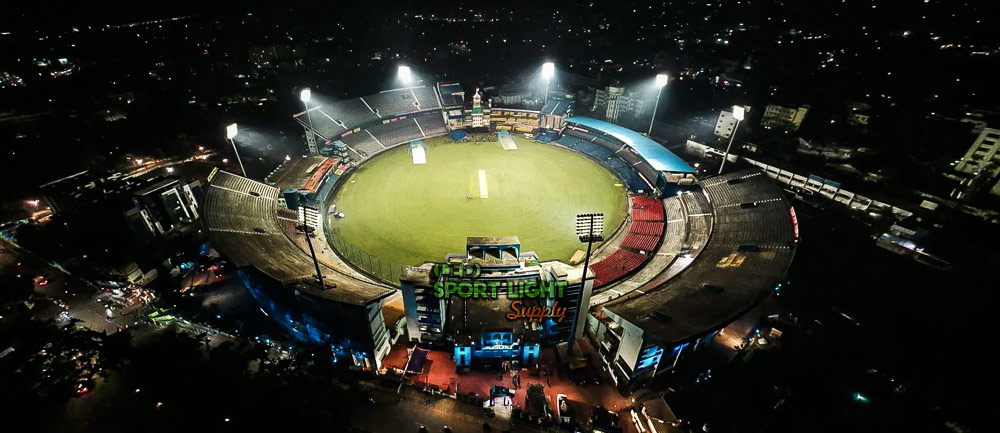
The design of lighting for an outdoor cricket stadium centers on achieving efficiency. A lighting designer meticulously studies the field to balance luminous intensity with total power consumption.
To develop an effective lighting layout, experts collect and analyze various data points. This data is then input into specialized software to determine the optimal setup. The primary objectives include:
- Determining the number of light poles required
- Positioning these poles within the stadium
- Establishing the height of the high masts
An effective lighting layout ensures uniform illumination across the field, from the bowler’s delivery to the fielders in key positions.
Number of Cricket Ground Light Poles
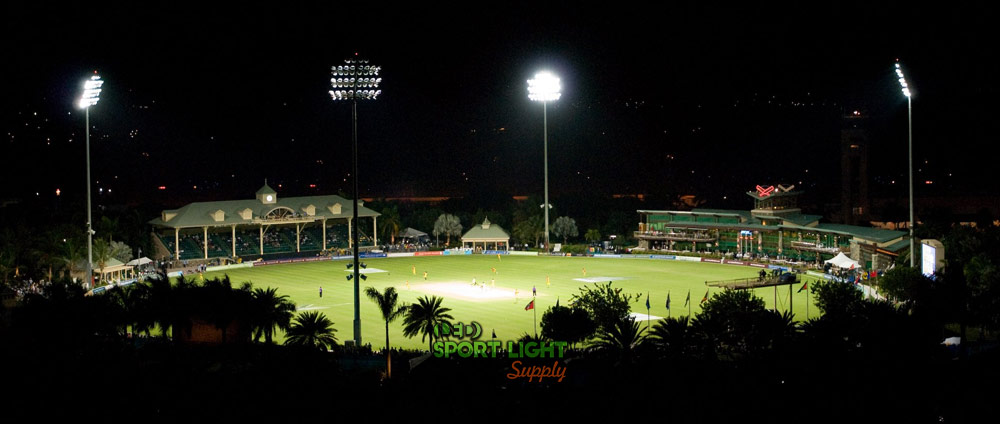
When choosing the number of light poles for a cricket stadium, the level of play is a critical factor. For televised matches, additional light poles are recommended. Typically, 4-pole and 6-pole designs are common.
Increasing the number of light poles enhances lighting quality, softening or eliminating shadows cast by players. This is essential for broadcasters who require high-quality LED flood lights to capture clear and realistic footage. Moreover, having more masts allows better control of light pollution. For a 4-pole setup, broad beam angles are necessary to meet lighting standards.
Position of the Light Poles
Proper positioning of light poles is crucial to avoid glare and ensure effective lighting. The placement of each pole should adhere to the aiming philosophy outlined in lighting standards such as AS/NZS 4282:2019, which addresses issues like light pollution, glare control, and safety.
Typically, a clearance zone of 5 meters from the boundary line to the high mast position is recommended, though a fence can provide basic protection. If specific cricket lighting standards are not available, consulting other sports lighting standards may provide useful guidance, as some standards apply across multiple sports.
Height of Light Poles
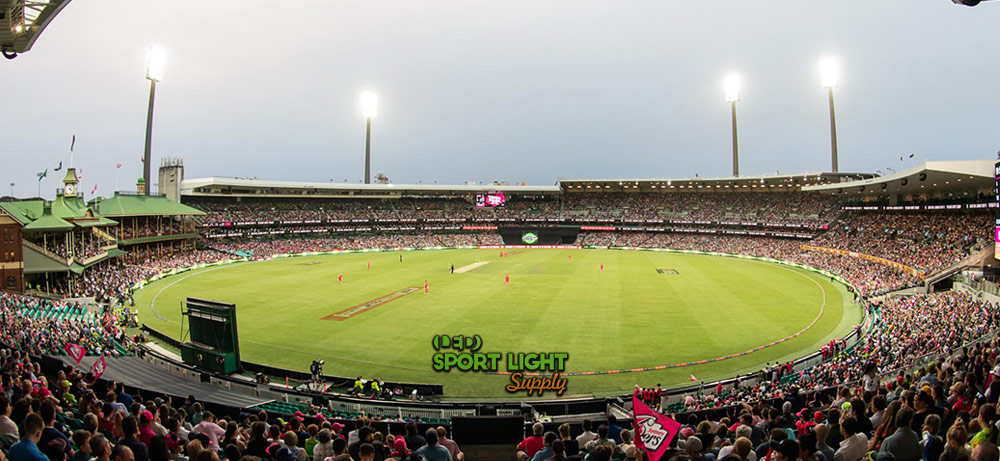
The height of light poles ranges from 14 to 40 meters, depending on the level of competition. Higher poles generally offer better light distribution and reduce glare, ensuring that players and spectators have optimal visibility. For local or non-professional matches, a formula for calculating pole height is to multiply the distance from the pole to the field center by 0.36. However, for first-class and international competitions, it is advisable to use poles that are at least 26 meters tall, aiming for a 25-degree angle from the lowest pole to the center of the field.
Indoor Cricket Ground and Practice Net Lighting Layout
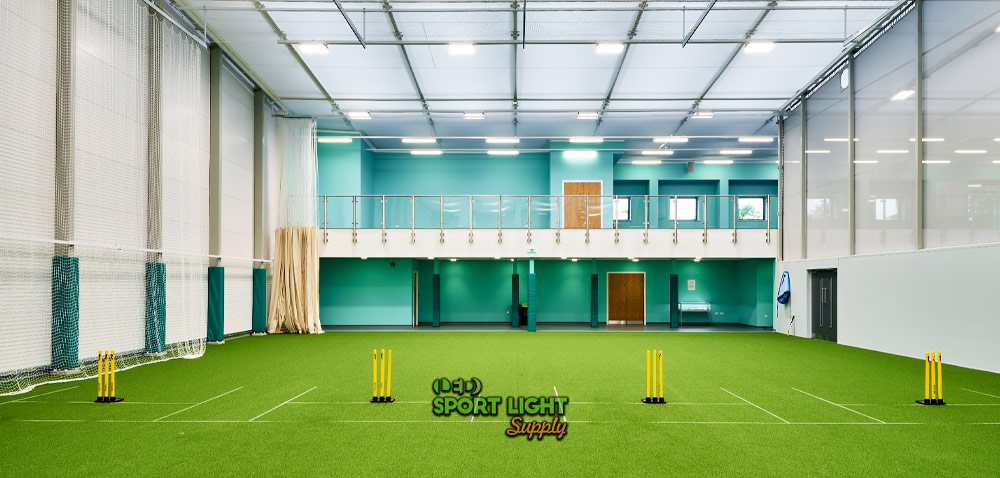
Designing lighting for an indoor cricket facility presents unique challenges due to space constraints and the need for effective illumination. This layout needs to address both the cricket ground and practice nets, with considerations for ceiling height, lighting types, and fixture placement.
Ceiling Height
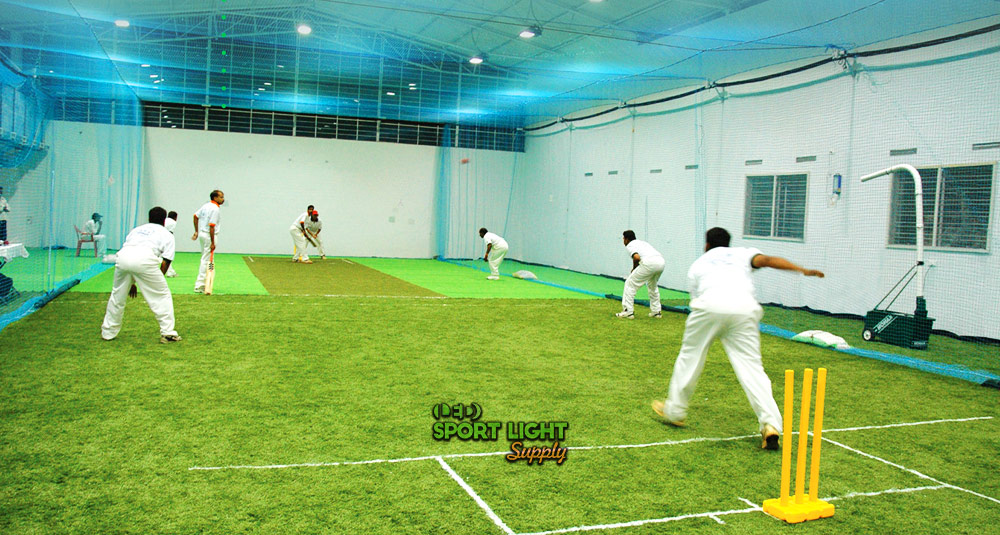
The recommended ceiling height for indoor cricket facilities ranges from 4 to 4.5 meters. This height is essential to allow batsmen sufficient space to execute shots without restriction. A higher ceiling helps players improve their footwork and technique by providing enough clearance for the ball. A minimum height of 4 meters is crucial to prevent the ball from hitting the ceiling prematurely, which could impede practice and coaching effectiveness.
Direct vs. Indirect Lighting for Practice Nets
Choosing between direct and indirect lighting is a critical decision:
- Direct Lighting: Fixtures are aimed downward, providing direct illumination to the cricket ground. This approach tends to create higher contrast and can sometimes lead to glare.
- Indirect Lighting: Fixtures are aimed upwards, and the light is reflected off the ceiling to illuminate the cricket ground. While this method offers more uniform lighting and a sophisticated ambience, it requires additional fixtures and can lead to light loss of 10% to 30%, depending on ceiling material.
Distance Between High Bay Lights and Ceiling
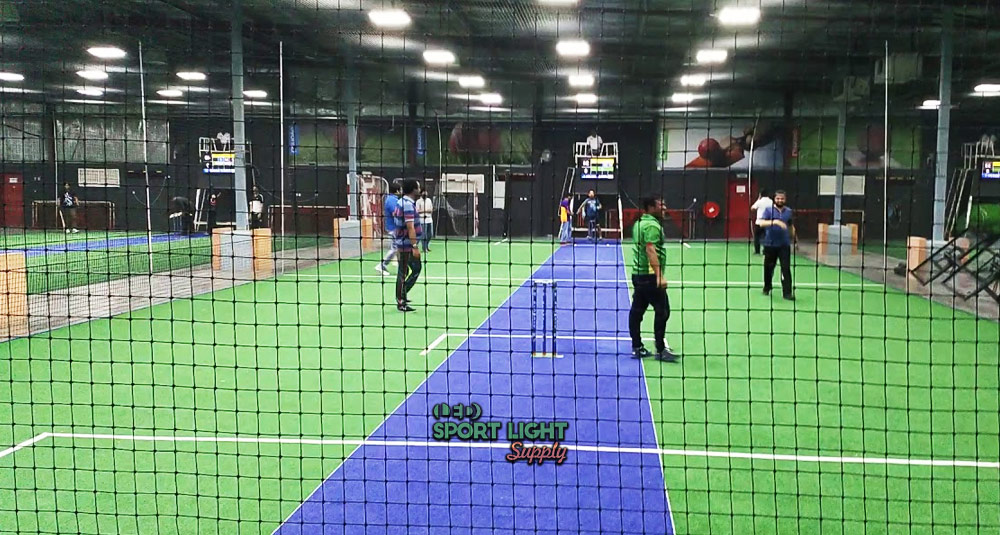
The spacing between high bay lights and the ceiling generally ranges from 1.5 to 3 meters (5 to 10 feet), depending on the beam angle and ceiling height. Typically, one light fixture is required for every 30 x 30 square meter area. However, the specific setup may vary based on the chosen lighting type and beam angle. High bay lights are commonly used in indoor sports facilities and are usually installed on frames or sockets with appropriate wiring.
Distance Between Lighting Fixtures and Practice Net Wall
To minimize shadows created by practice nets, maintain a distance of at least 1.5 meters (5 feet) between the lighting fixtures and the practice net wall. This spacing helps ensure that shadows do not obscure the playing area, providing optimal visibility for both players and coaches. This standard applies regardless of the netting arrangement, whether it includes tunnel-like sections or separate practice pitches.
Indoor Cricket Net Size and Lighting Requirements
The size of the cricket net affects the number of lights needed. The general requirement is one light for every 30 x 30 square meter area. However, as the size of the net increases, the beam angle of the lights becomes more critical. Cricket nets typically come in standard sizes of 3.60 meters, 3 meters, and 2.70 meters. The ceiling height and net thickness may necessitate additional LED lights to ensure even illumination and meet lighting requirements.
Cricket Stadium Lighting Design and Standards
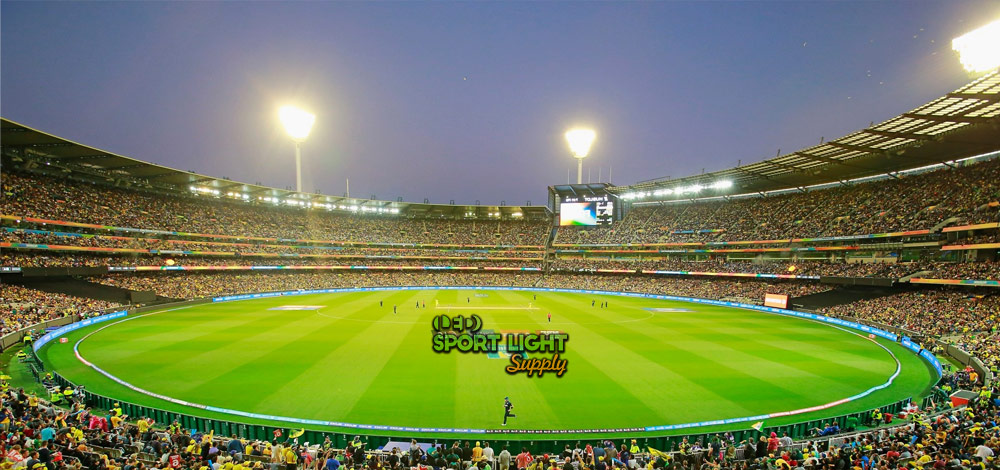
Understanding cricket stadium lighting design and standards is essential for ensuring optimal performance and cost-effectiveness. By familiarizing yourself with the lighting requirements and standards, you can make informed decisions and reduce operational costs. Below is an overview of key aspects related to cricket stadium lighting design.
Lux (Footcandle) Lighting Requirement for Cricket Stadiums
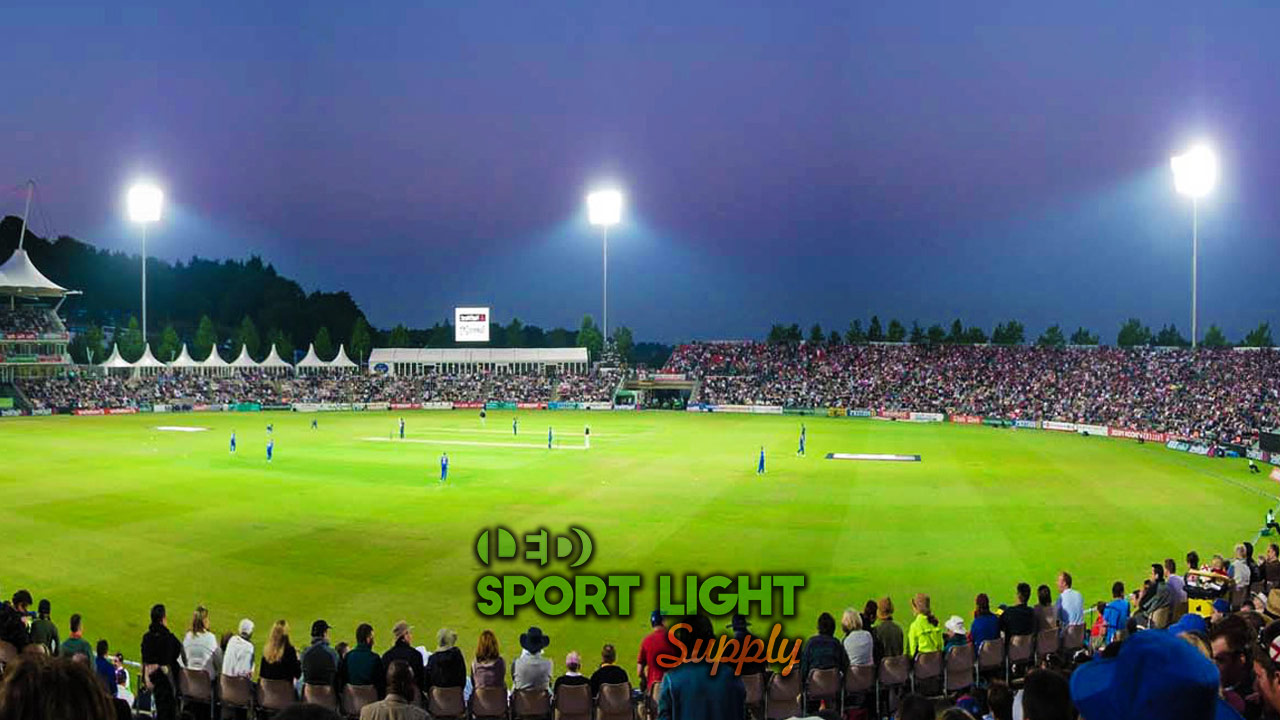
Lux, the standard SI unit for illuminance, measures the amount of light flux intercepted by a surface. In cricket, it’s crucial to distinguish between different levels of play and their corresponding lighting requirements. The required illuminance varies depending on the competition level and whether the match is televised.
| Lighting Class | Infield Lux Level | Outfield Lux Level |
|---|---|---|
| Class I | 750 lux | 500 lux |
| Class II | 500 lux | 300 lux |
| Class III | 300 lux | 200 lux |
| International Tournaments & 4K Broadcasting | 1500-2000 lux | 1500-2000 lux |
For example, Class I stadiums, which are top national and professional facilities, require 750 lux for the infield and 500 lux for the outfield. This ensures a high-quality viewing experience and player performance. Class II stadiums, used for national club competitions, have slightly lower requirements of 500 lux for the infield and 300 lux for the outfield. Class III, typically used for local matches, requires 300 lux for the infield and 200 lux for the outfield.
For international tournaments and high-definition broadcasting, the lighting requirements increase significantly. To meet the needs of 4K broadcasting, infield lux levels should be between 1500 and 2000 lux. This higher illuminance is essential for capturing every detail in the broadcast feed and ensuring top-notch visual quality.
A professional lighting design must account for these varying lux levels to ensure that players can perform optimally and viewers can enjoy a clear and detailed broadcast. Lux assessments should also consider maintenance factors, as the brightness of LED fixtures can diminish over time.
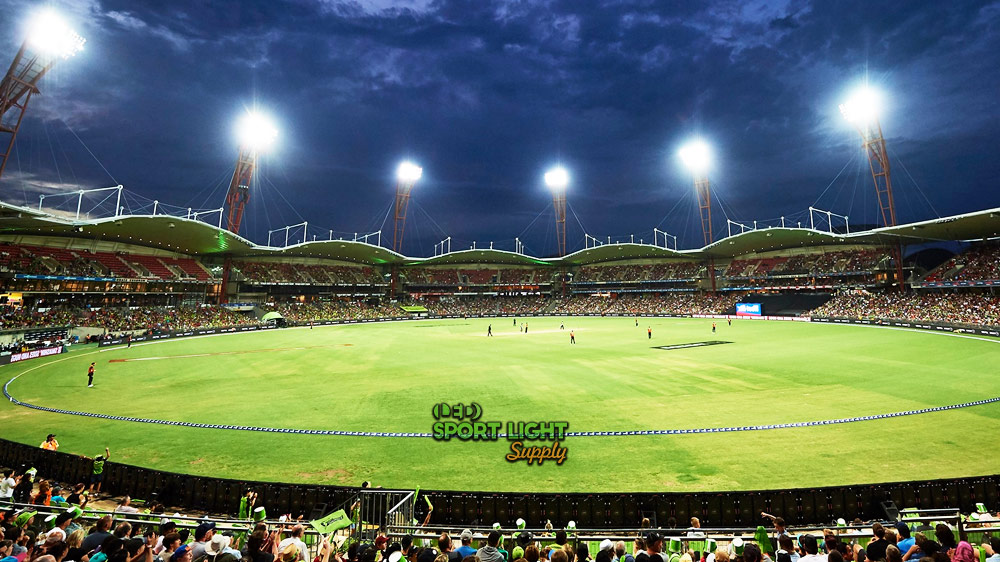
Lighting Uniformity Standards for Cricket Fields
Uniformity in lighting ensures that no part of the cricket field is excessively bright or dark. This even distribution of light is critical for player performance and safety. Lighting uniformity is measured using two key ratios: U1 and U2. U1 is the ratio between the minimum and average illuminance, while U2 is the ratio between the minimum and maximum illuminance.
For cricket fields, the standards specify that the maximum uniformity gradient must be less than or equal to 20% per 5 meters. This means that no part of the field should be more than 20% brighter or darker than adjacent areas. For Class I and Class II stadiums, U1 should be 0.7 and U2 should be 0.5 for the infield. For the outfield, U1 should be 0.5 and U2 should be 0.4. Class III stadiums have slightly lower requirements, with U1 at 0.5 and U2 at 0.3 for the infield.
Maintaining high lighting uniformity is crucial for ensuring that players can track the ball and react quickly to game situations. Any significant variation in lighting can lead to distractions or hinder performance. Thus, achieving and maintaining these uniformity standards is a key aspect of lighting design.
Color Temperature
Color temperature, measured in Kelvin (K), indicates the hue of the light emitted by a source. In cricket stadiums, a color temperature between 5000K and 6000K is generally recommended. This range mimics natural daylight and provides a clear, crisp light that helps players see the ball more effectively.
Although there are no specific cricket field lighting standards mandating a particular color temperature, using light in this range can improve player visibility and performance. It also ensures that the color of the ball and players’ uniforms appear natural and consistent under artificial lighting.
CRI and TLCI
The Color Rendering Index (CRI) and Television Lighting Consistency Index (TLCI) are important for evaluating the quality of lighting. CRI measures how accurately a light source renders colors compared to natural light. A high CRI value, ideally ≥ 65, ensures that colors appear true to life.
TLCI, on the other hand, is crucial for broadcast environments. It measures how well a light source renders colors on camera. For televised events, a high TLCI value is necessary to ensure that the broadcast footage is vibrant and accurate. Both CRI and TLCI values should be high to ensure that the lighting meets the needs of both players and broadcasters.
Flicker-Free Lighting
Flicker-free lighting is essential for capturing smooth, clear footage during live broadcasts. Flickering can cause visual distortions and affect the quality of video recordings. Modern LED lights are designed to be flicker-free, ensuring that broadcasts and live streams are free from unwanted visual artifacts.
In older cricket stadiums or facilities using outdated lighting technology, it may be necessary to upgrade to flicker-free LED lights to meet current broadcasting standards. Ensuring that all lighting fixtures are flicker-free is crucial for maintaining high-quality video content.
Glare
Glare can significantly impact players’ visibility and safety. The glare rating, or GR value, should be kept below 50 to ensure that players and spectators are not subjected to excessive brightness or discomfort. Proper installation of light fixtures and the use of shielding can help manage glare effectively.
In outdoor stadiums, lights should be aimed downward to minimize glare. For indoor facilities, additional measures such as shielding may be required to control glare. Addressing glare is vital for maintaining a comfortable and safe playing environment.
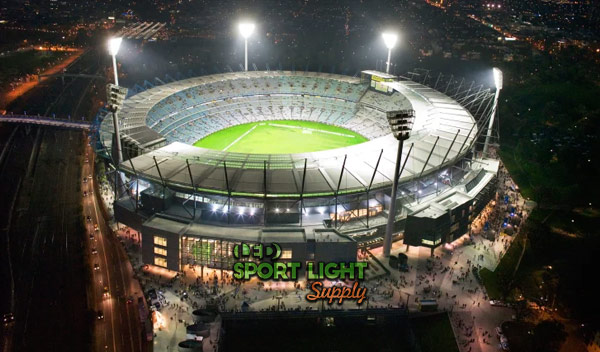
Light Pollution (Light Spill)
Light pollution, or light spill, occurs when excess light spills beyond the intended area, potentially affecting nearby residential areas or wildlife. Reducing light pollution involves using lighting fixtures with appropriate beam angles and controlling the height of light poles.
Effective strategies to mitigate light spill include using fixtures that direct light precisely where needed and employing shielding techniques to prevent unwanted light from escaping. Addressing light pollution is not only important for maintaining good relationships with the community but also for minimizing the impact on local ecosystems.
How to Choose the Right Lighting System for Cricket Stadiums in India?
Waterproof Lighting Fixtures for Indian Cricket Stadiums
India’s tropical climate presents unique challenges for outdoor cricket facilities. Frequent rainfall and high humidity necessitate the use of waterproof lighting fixtures to ensure reliable operation and longevity. For this purpose, LED flood lights with a high Ingress Protection (IP) rating are essential. Specifically, IP68-rated fixtures are recommended as they provide complete protection against dust ingress and can withstand prolonged exposure to water. This level of protection ensures that the lighting system remains functional and durable despite the harsh weather conditions typical in India.
Lightning Protection
India’s susceptibility to cyclonic storms and frequent lightning strikes makes lightning protection a critical consideration for cricket stadium lighting systems. Installing a suitable lightning rod is crucial to safeguard both the lighting fixtures and the safety of people around the stadium. Lightning protection systems should be in accordance with the latest standards and technological advancements. To ensure compliance and effectiveness, consult with local authorities or agencies specializing in energy and environmental safety. While total protection from lightning may not be feasible, proactive measures can significantly mitigate damage and enhance safety.
Heat Dissipation System
The intense heat during India’s pre-monsoon season, with temperatures often exceeding 35°C (95°F), requires effective heat management in cricket stadium lighting systems. LED lights are particularly suited for this environment due to their efficiency and lower heat output compared to traditional lighting sources. However, it’s crucial to ensure that the LED fixtures are equipped with an effective heat dissipation system. This typically includes built-in heatsinks designed to transfer heat away from the lamp body. For exceptionally hot locations, consider custom solutions to enhance the heat dissipation capabilities and maintain optimal performance of the lighting system.
Low Consumer Price Index (CPI)
Cost management is an important aspect when selecting lighting solutions for cricket stadiums. While LED lights are generally more expensive upfront compared to other types, their long lifespan and energy efficiency can offset initial costs. In India, where price fluctuations can impact budgets, keeping an eye on the Consumer Price Index (CPI) can help in making cost-effective decisions. Ideally, cricket stadium lights should be durable, with a lifespan of over 150,000 hours, to maximize the return on investment. Monitoring economic policies and market trends can also provide insights into making informed purchasing decisions while ensuring budgetary efficiency.
Advantages of Replacing Traditional Cricket Field Lighting with LEDs
Energy Efficiency
LED sports lights offer a remarkable economic benefit due to their high efficiency. They produce light that is up to five times more intense than traditional lighting sources while consuming the same amount of power. This efficiency translates to less energy being converted into heat, meaning LEDs remain relatively cool even after extended use. As a result, LEDs are not only energy-efficient but also compatible with alternative energy sources, such as solar power. Solar-powered LED systems allow you to harness daylight to power the lights, providing dual savings. By opting for LED flood lights with equivalent lumen output but lower wattage or incorporating solar panels, you can significantly reduce your energy costs.
Longevity
LED lights are known for their impressive lifespan, averaging around 100,000 hours. This durability greatly surpasses that of other lighting types. For instance, halogen bulbs typically last between 2,000 and 4,000 hours, while mercury vapor and HPS lamps usually have lifespans of about 20,000 hours. Metal halide lamps, which are somewhat more durable, last up to 30,000 hours at best. The extended lifespan of LEDs means fewer replacements and lower maintenance costs, making them a more cost-effective solution in the long run.
Superior Lighting Uniformity
The controlled light emission of LEDs results in superior lighting uniformity. LED lamps are equipped with diodes that provide more precise light distribution. Advanced technologies, such as Surface-Mounted Devices (SMDs) and Chip-on-Board (COB) models, contribute to this uniformity by minimizing shadows and ensuring an even spread of light across the cricket field. These high-efficiency chips help meet stringent lighting standards and enhance the overall visibility and quality of the illumination, which is crucial for both players and spectators.
Enhanced Color Rendering Index (CRI)
LED lights excel in color rendering, a key factor for high-quality lighting. The Color Rendering Index (CRI) measures how accurately a light source displays colors compared to natural light, with a scale ranging from 0 to 100 Ra. Most LED lights achieve a CRI higher than 90, indicating excellent color accuracy. Professional cricket ground LEDs can reach up to 95 Ra, providing vivid and accurate color representation. This high CRI enhances the viewing experience for spectators, making every detail of the game more engaging and visually appealing.
Advanced Smart Lighting Control
LED lighting systems offer advanced control features that enhance convenience and flexibility. With smart stadium lighting control options, you can adjust the brightness, switch the lights on and off, and create special effects from a computer or smartphone. The intuitive interface allows for seamless management of lighting settings from a single control station. This capability streamlines operations and improves user experience, enabling you to fine-tune the lighting to suit various needs and create the ideal atmosphere for every match.
How to Choose the Best Cricket Ground and Stadium Lights?
Lighting Efficiency
When selecting LED lighting for cricket grounds and stadiums, one of the most critical factors to consider is lighting efficiency. High-quality LED products should offer more than 150 lumens per watt. This efficiency metric indicates the manufacturing quality of the LED chip and its ability to produce a high amount of light while consuming less power.
The performance of an LED light can vary significantly depending on the size and quality of the chip used. Larger chips generally provide better brightness and heat dissipation, leading to improved overall performance and longer lifespan. Smaller chips, while potentially more compact, tend to generate more heat and may offer lower light output. Therefore, choosing a fixture with a high lumen-per-watt ratio and a well-designed chip is essential for optimal lighting performance and energy efficiency.
Beam Angle
The beam angle of the lighting fixtures plays a crucial role in how effectively the light covers the cricket field. A wide beam angle is ideal for general field lighting, ensuring that large areas are evenly illuminated. This is especially important for areas such as the outfield and advertising boards.
Conversely, a narrow beam angle is better suited for focused lighting needs, such as spotlighting the wickets or the players. It’s important to ensure that the lighting design does not cause glare or blind the players. The goal is to provide clear, even illumination without compromising visibility or player comfort. Proper beam angle selection will enhance the lighting design and contribute to a more effective and enjoyable playing experience.
Lifespan
The lifespan of the lighting fixtures is a key consideration when purchasing stadium lights. LED lights are known for their long operational life, often exceeding 150,000 hours. This longevity not only reduces the frequency of replacements but also minimizes maintenance needs.
Durable LED lights are designed to withstand harsh environmental conditions, making them a reliable choice for cricket stadiums exposed to varying weather conditions. Investing in high-quality, long-lasting lights will ensure consistent performance and reduce long-term maintenance costs, providing value and reliability over the lifespan of the fixtures.
Anti-Glare Features
Glare can be a significant issue with traditional floodlights, which often use cup lenses that can intensify light and cause visual discomfort. Modern LED lights come equipped with anti-glare lenses that help mitigate this problem. These lenses are designed to direct light precisely where it’s needed while minimizing glare and preventing direct light from hitting the players’ eyes.
In addition to anti-glare lenses, consider fixtures that include filters, shielding, or other accessories to further reduce glare. These components enhance the quality of the lighting and improve the overall experience for players and spectators. Be sure to check with the supplier to see if these accessories are available and compatible with the lighting fixtures you’re considering.
Portable Cricket Field Lights vs. Permanent Light Poles
When deciding between portable cricket field lights and permanent light poles for your cricket stadium, several factors need to be considered to ensure you make the most suitable choice for your needs. Each option has its benefits and drawbacks, depending on your specific requirements and budget.
Solar Panel Compatibility
One significant advantage of portable cricket field lights is their compatibility with solar panels. Even if you are not planning to invest in solar energy immediately, it’s wise to consider future possibilities. Advances in renewable energy technology may make solar panels more cost-effective over time.
Having the option to integrate solar panels into your lighting system can be beneficial. Smaller solar panels can be used to recharge the batteries of portable light towers, and you can also place solar lights in various areas around the stadium, such as the parking lot. This approach can lead to long-term cost savings and a more sustainable lighting solution.
Installation Difficulty
The installation process for portable cricket field lights is generally straightforward, which can be advantageous if you need temporary lighting or are working within a tight timeframe. Permanent light poles, on the other hand, may involve more complex installation, especially if you are renovating or retrofitting an existing lighting layout.
When converting from traditional lighting systems to LED lights, professional assistance might be required. The complexity can vary depending on the existing infrastructure and the type of lights being replaced. For new installations, opting for LED lights is usually a hassle-free choice, minimizing future issues with accidental replacements and ensuring compatibility with modern lighting technologies.
Warranty Considerations
Warranty is an essential factor when purchasing lighting equipment. A longer warranty period generally indicates higher product quality and durability. High-quality cricket stadium lights often come with extended warranties, which provide peace of mind and protection against potential issues.
Be cautious of cheaper products that offer only one or two years of warranty, as they may be more prone to malfunction or reduced luminous efficiency over time. Investing in lights with a robust warranty can help avoid frequent replacements and ensure that you receive reliable performance throughout the lifespan of the fixtures.
How to Reduce Cricket Stadium Lighting Costs?
Getting a Good Lighting Design
Investing in a professional lighting design and layout is crucial for reducing the costs associated with cricket stadium lighting. A well-executed lighting plan not only optimizes the use of LED floodlights but also ensures cost-effectiveness by avoiding the installation of unnecessary lights and incorrect wattages. Utilizing advanced tools such as DIALux, which provides a detailed photometric analysis, allows for the creation of a precise and efficient lighting layout. This approach ensures that the lighting system is tailored to the specific needs of the cricket stadium, ultimately leading to reduced operational costs and improved performance.
Using Uniform Lighting Fixtures
Standardizing the types of lighting fixtures used throughout the cricket field can lead to significant cost savings. By selecting fixtures with the same power, lumen output, beam angle, and color temperature, the installation process becomes more straightforward and economical. Uniform lighting fixtures simplify maintenance and reduce labor costs associated with repairs and replacements. When all lights are of the same type, electricians encounter fewer issues during updates, and the process of replacing defective lights becomes more efficient. Additionally, having a stock of spare floodlights can help address temporary issues promptly and effectively, ensuring minimal disruption to the lighting system.
Reducing Light Pole Height
Adjusting the height of light poles can also contribute to cost savings. Lowering the poles can decrease light loss and reduce the number of fixtures needed. However, it is essential to balance this with the need for consistent lighting uniformity. Lowering the poles might slightly affect the evenness of illumination, and there could be potential safety concerns if not carefully managed. Conducting thorough testing to determine the optimal pole height ensures that lighting performance is maintained without compromising player safety. It may take some experimentation to find the right height that provides effective lighting while achieving cost reductions.
Increasing the Number of Poles
Installing additional light poles around the cricket ground is another effective strategy for reducing lighting costs. By increasing the number of poles, each one covers a smaller area, which helps to minimize light loss and maintain consistent illumination across the field. Adding just a few more poles, such as in a six-pole layout, can significantly reduce running costs while ensuring that the lighting coverage remains adequate. However, it is crucial to perform precise calculations and planning to achieve the best results. Properly designed lighting layouts ensure that the added poles contribute to the overall efficiency of the lighting system without leading to unnecessary expenses.
How to Select the Best Cricket Stadium Lighting Companies and Suppliers?
Expertise and Experience
When selecting a company for your cricket stadium lighting needs, it’s crucial to consider their expertise and experience. Different companies specialize in various aspects of lighting projects, with some focusing on new installations while others excel in repairs and retrofitting. To make an informed choice, evaluate the company’s recent projects and visit completed sites to assess their reliability and competence in cricket field lighting. Understanding their track record will give you insight into their ability to deliver high-quality results and handle the specific demands of a cricket stadium.
Pricing
Price is a significant factor in choosing a lighting company, but it should not be the sole criterion. An extremely low price may indicate the use of substandard products, outdated LED technology, or unskilled labor, which could compromise the quality and longevity of your lighting system. Conversely, an excessively high price may suggest that the company is not managing its workload efficiently or that it may be overcharging due to lack of competition. A balanced approach is necessary: aim for a company that offers reasonable pricing based on a detailed quote and transparency about their services. Make sure to discuss their pricing structure and recent projects to gauge whether their fees align with their offerings.
Free Lighting Design and Customization
A reputable lighting company should provide a comprehensive and transparent quote that includes a detailed DIALux photometric simulation report. This report is essential for understanding how the proposed lighting design will perform. Look for companies that offer customized solutions tailored to your specific needs rather than just opting for the lowest cost. A professional company will work closely with you to understand your vision and offer a lighting design that aligns with your goals, ensuring the best possible outcome for your cricket stadium.
Research and Development
The presence of a dedicated Research and Development (R&D) department is a strong indicator of a company’s commitment to innovation and product improvement. Companies with active R&D departments are continually enhancing the quality of their lighting products and staying abreast of the latest technological advancements. In contrast, companies without R&D may simply act as resellers, offering no significant improvement over existing products. Ensure that the company you choose invests in R&D to provide cutting-edge solutions and maintain high standards in their lighting products.
Customer Service
Effective customer service is vital throughout the project lifecycle. The quality of customer service reflects a company’s commitment to client satisfaction. During the planning, installation, and post-installation phases, you may have numerous questions and concerns. A responsive and attentive customer service team is essential for addressing these issues promptly and professionally. Evaluate the company’s customer service by assessing their response time and willingness to provide thorough answers and support. Good customer service involves not only answering questions but also proactively guiding clients through the process and addressing any issues that arise.
Cricket Stadium Lighting Questions and Answers
How Many Watts and Lumens Are Cricket Stadium Lights?
The precise wattage and lumens required for cricket stadium lights depend heavily on the specific lighting design and layout of the stadium. However, as a general guideline, individual cricket stadium lights typically range between 400 watts and 2,000 watts, translating to approximately 60,000 to 300,000 lumens per light. For an entire cricket stadium, the total wattage required can range from 50,000 watts to 300,000 watts, depending on factors such as the size of the cricket field and the level of competition.
The primary objective of a cricket stadium lighting system is to achieve an overall illumination level of between 7,500,000 and 45,000,000 lumens. This range ensures that the lighting is adequate for both player visibility and broadcast quality, catering to the needs of high-level cricket matches.
Can We Use Solar Flood Lights in a Cricket Stadium?
Solar LED flood lights offer a more energy-efficient alternative to traditional lighting options. However, there are some limitations to consider. Solar batteries typically charge more slowly on cloudy days and generally provide illumination for only 3 to 5 hours after a full charge. As a result, the feasibility of using solar lighting solutions in a cricket stadium will depend on factors such as the local climate and the specific lighting needs of the facility.
For both indoor and outdoor cricket fields, implementing solar lighting may require customized design solutions. Despite these challenges, solar lighting can significantly reduce operational costs and extend the accessibility of the sports facility to community events and senior cricket clubs, potentially generating additional revenue.
What Are the Common Cricket Field Dimensions?
Cricket fields are generally oval or rectangular and are made of grass. The typical diameter of a cricket field ranges from 130 to 150 meters. While cricket fields are often larger than football pitches, there is no universal standard for their exact dimensions. The available space is used to its maximum extent, with the field size often influenced by factors such as the level of play and the orientation of the cricket pitch.
In the center of the field, the cricket pitch itself measures approximately 20 meters in length and 3 meters in width. The orientation of the pitch and the level of play can affect the overall size of the cricket ground, influencing the design and layout of the lighting system.
Conclusion
This guide aims to provide the latest information on cricket stadium lighting standards. As cricket gains popularity worldwide, adhering to lighting requirements becomes increasingly important. The guide addresses common questions about lighting specifications, solar options, and field dimensions, helping you make informed decisions about your cricket field lighting system.
For further assistance or more details on custom cricket ground lighting solutions, feel free to contact us. We offer high-quality LED cricket stadium lights, precise photometric simulation reports, and expert advice to ensure your lighting system meets the highest standards.
